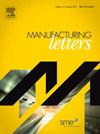Effects of beam shaping on temperature, pool geometry, and cooling rate in laser powder bed fusion
IF 2
Q3 ENGINEERING, MANUFACTURING
引用次数: 0
Abstract
Laser beam shaping is a process of adjusting the intensity profile of the beam to generate an optimal energy distribution at a specific location. In laser powder bed fusion (LPBF), the shape of the laser beam impacts peak temperature, melt pool geometry, and cooling rates, however, a detailed scientific understanding of these effects is lacking. In this research, a 3D transient heat transfer model is implemented to investigate the dependence of temperature fields, melt pool geometry, and cooling rates on six different laser beam shapes: Gaussian, elliptical-Gaussian, top hat, flat top, ring-shaped, and adjustable mode beam. The model results are validated using experimental data for different beam shapes during LPBF of an aluminum alloy, AlSi10Mg. We found that a Gaussian beam, with its concentrated power, results in high peak temperatures and a larger melt pool with slow cooling, whereas an elliptical Gaussian beam produces a wider pool. The top hat and flat top beams distribute power more uniformly, leading to lower peak temperatures and faster cooling, with the flat top beam creating a wider but shallower pool. The ring-shaped beam, spreading energy over a larger area, significantly reduces peak temperature and cooling rate, while the adjustable mode beam with 80 % power in the outer ring exhibits similar temperature fields and pool dimensions to the ring-shaped beam.
光束成形对激光粉末床熔合过程中温度、熔池几何形状和冷却速率的影响
激光束整形是一种调整光束强度分布以在特定位置产生最佳能量分布的过程。在激光粉末床熔合(LPBF)中,激光束的形状影响峰值温度、熔池几何形状和冷却速率,然而,缺乏对这些影响的详细科学理解。在这项研究中,实现了一个三维瞬态传热模型,研究了温度场、熔池几何形状和冷却速率对六种不同激光束形状的依赖:高斯、椭圆高斯、大礼帽、平顶、环形和可调模式光束。在AlSi10Mg铝合金LPBF过程中,采用不同光束形状的实验数据对模型结果进行了验证。我们发现,高斯光束的功率集中,导致峰值温度高,熔池较大,冷却缓慢,而椭圆高斯光束产生更宽的熔池。顶帽和平顶光束更均匀地分配能量,导致更低的峰值温度和更快的冷却,平顶光束创造了一个更宽但更浅的池。环形梁将能量扩散到更大的区域,显著降低了峰值温度和冷却速率,而外环功率为80%的可调模梁具有与环形梁相似的温度场和池尺寸。
本文章由计算机程序翻译,如有差异,请以英文原文为准。
求助全文
约1分钟内获得全文
求助全文
来源期刊

Manufacturing Letters
Engineering-Industrial and Manufacturing Engineering
CiteScore
4.20
自引率
5.10%
发文量
192
审稿时长
60 days
 求助内容:
求助内容: 应助结果提醒方式:
应助结果提醒方式:


